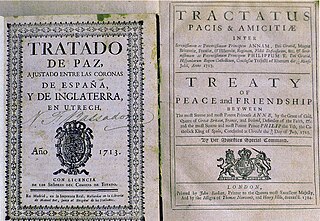Related Research Articles

The Thirty Years' War was one of the longest and most destructive conflicts in European history, lasting from 1618 to 1648. Fought primarily in Central Europe, an estimated 4.5 to 8 million soldiers and civilians died as a result of battle, famine, and disease, while some areas of what is now modern Germany experienced population declines of over 50%. Related conflicts include the Eighty Years' War, the War of the Mantuan Succession, the Franco-Spanish War, the Dutch-Portuguese War and the Portuguese Restoration War.

The War of the Spanish Succession was a European great power conflict that took place from 1701 to 1715. The death of childless Charles II of Spain in November 1700 led to a struggle for control of the Spanish Empire between his heirs, Philip of Anjou and Charles of Austria, and their respective supporters, among them Spain, Austria, France, the Dutch Republic, Savoy and Great Britain. Related conflicts include the 1700–1721 Great Northern War, Rákóczi's War of Independence in Hungary, the Camisards revolt in southern France, Queen Anne's War in North America and minor trade wars in India and South America.

The House of Wittelsbach is a former German dynasty, with branches that have ruled over territories including the Electorate of Bavaria, the Electoral Palatinate, the Electorate of Cologne, Holland, Zeeland, Sweden, Denmark, Norway, Hungary, Bohemia, and Greece. Their ancestral lands of Bavaria and the Palatinate were prince-electorates, and the family had three of its members elected emperors and kings of the Holy Roman Empire. They ruled over the Kingdom of Bavaria which was created in 1805 and continued to exist until 1918.

Leopold I was Holy Roman Emperor, King of Hungary, Croatia, and Bohemia. The second son of Ferdinand III, Holy Roman Emperor, by his first wife, Maria Anna of Spain, Leopold became heir apparent in 1654 after the death of his elder brother Ferdinand IV. Elected in 1658, Leopold ruled the Holy Roman Empire until his death in 1705, becoming the second longest-ruling Habsburg emperor. He was both a composer and considerable patron of music.

The Peace of Utrecht was a series of peace treaties signed by the belligerents in the War of the Spanish Succession, in the Dutch city of Utrecht between April 1713 and February 1715. The war involved three contenders for the vacant throne of Spain, and involved much of Europe for over a decade. The main action saw France as the defender of Spain against a multinational coalition. The war was very expensive and bloody and finally stalemated. Essentially, the treaties allowed Philip V to keep the Spanish throne in return for permanently renouncing his claim to the French throne, along with other necessary guarantees that would ensure that France and Spain should not merge, thus preserving the balance of power in Europe.

The Peace of Ryswick, or Rijswijk, was a series of treaties signed in the Dutch city of Rijswijk between 20 September and 30 October 1697. They ended the 1688 to 1697 Nine Years' War between France and the Grand Alliance, which included the Dutch Republic and the Holy Roman Empire.

The Grand Alliance was the anti-French coalition formed on 20 December 1689 between the Dutch Republic, England and the Holy Roman Empire. It was signed by the two leading opponents of France: William III, Stadtholder of the Dutch Republic and King of England, and Emperor Leopold I, on behalf of the Archduchy of Austria.

Theresa Kunegunda, was a Polish princess, Electress of Bavaria and of the Electorate of the Palatinate. By birth she was member of the House of Sobieski and by marriage member of the House of Wittelsbach. She also served as Regent of the Palatinate in 1704–05.

The Second Silesian War was a war between Prussia and Austria that lasted from 1744 to 1745 and confirmed Prussia's control of the region of Silesia. The war was fought mainly in Silesia, Bohemia, and Upper Saxony and formed one theatre of the wider War of the Austrian Succession. It was the second of three Silesian Wars fought between Frederick the Great's Prussia and Maria Theresa's Austria in the mid-18th century, all three of which ended in Prussian control of Silesia.

The Peace of Füssen was a peace treaty signed at Füssen, between the Electorate of Bavaria and Habsburg Austria. Signed on 22 April 1745, it ended the participation of Bavaria on the French side in the War of the Austrian Succession.

The Peace of Prague, signed on 30 May 1635, ended Saxony's participation in the Thirty Years War. Other German princes subsequently joined the treaty and although the Thirty Years War continued, it is generally agreed Prague ended it as a war of religion within the Holy Roman Empire. Thereafter, the conflict was largely driven by foreign powers, including Spain, Sweden, and France.

Maria Anna of Neuburg, was a German princess and member of the Wittelsbach family, who became Queen consort of Spain in 1689 as the second wife of Charles II, last Habsburg King of Spain.

The Kingdom of Bavaria was a German state that succeeded the former Electorate of Bavaria in 1805 and continued to exist until 1918. With the unification of Germany into the German Empire in 1871, the kingdom became a federated state of the new empire and was second in size, power, and wealth only to the leading state, the Kingdom of Prussia.
The Treaty of Teschen was signed on 13 May 1779 in Teschen, then in Austrian Silesia, between the Austrian Habsburg monarchy and the Kingdom of Prussia, which officially ended the War of the Bavarian Succession.

The 1698 Treaty of The Hague, also known as the 1698 Treaty of Den Haag or First Partition Treaty was one of two attempts by France, Great Britain, and the Dutch Republic to achieve a diplomatic solution to the issues that led to the 1701–1714 War of the Spanish Succession.

The Treaty of Fontainebleau was signed on 30 May 1631 during the Thirty Years' War, at the Palace of Fontainebleau. It was a pact of mutual assistance between Maximilian I, Elector of Bavaria, and France, for a period of eight years.

The Electorate of Bavaria was an independent hereditary electorate of the Holy Roman Empire from 1623 to 1806, when it was succeeded by the Kingdom of Bavaria.

The Treaty of Bärwalde, signed on 23 January 1631, was an agreement by France to provide Sweden financial support, following its intervention in the Thirty Years' War.

The Treaty of Nymphenburg was a treaty between Bavaria and Spain that was concluded on May 28, 1741 at the Nymphenburg Palace in Munich. It was the first formal pact of a series of French-sponsored alliances against the Habsburg Monarch, Maria Theresa. Through the agreement, the Bavarian Elector Charles Albert gained the support of King Philip V of Spain to become the next Holy Roman Emperor against the claims of the Habsburgs. The treaty was brokered by Marshal Belleisle under the authority of Louis XV of France. As part of the negotiations, the French agreed to materially support Charles Albert's claims. The treaty signaled the expansion of the First Silesian War, which started as a local war between Prussia and the Habsburg Monarchy, into the War of the Austrian Succession, a pan-European conflict.

The Convention of Milan, signed on 13 March 1707 during the War of the Spanish Succession, was an agreement between France and Austria which ended the fighting in Northern Italy. The French were allowed to withdraw their remaining forces undisturbed and in return handed control of any towns they still held to the Austrian commander Prince Eugene of Savoy.
References
- ↑ Ph.D, David T. Zabecki (2014-10-28). Germany at War: 400 Years of Military History [4 volumes]: 400 Years of Military History. ABC-CLIO. ISBN 978-1-59884-981-3.
- ↑ Rotteck, Carl von (1858). History of the World from the Creation to the Present Time ...
- ↑ Frey, Linda S.; Frey, Linda; Frey, Marsha (1995). The Treaties of the War of the Spanish Succession: An Historical and Critical Dictionary. Greenwood Publishing Group. ISBN 978-0-313-27884-6.